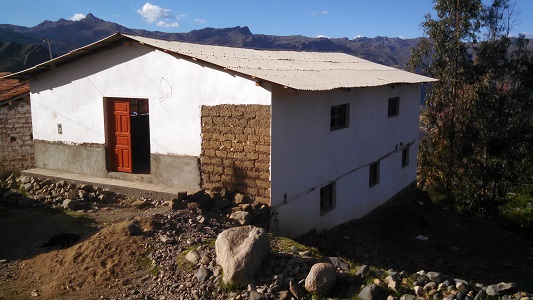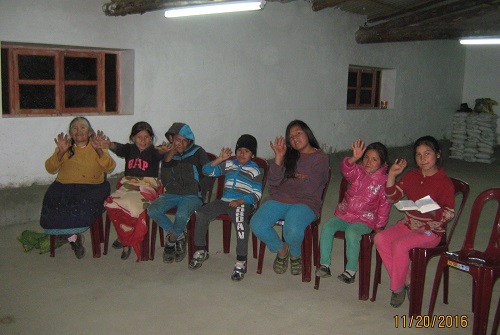Mission: Peru 2017
Fighting folk religion in the Andean mountains
By Gary Fallesen, founding president, Climbing For Christ
Jaime Servat surveyed the village of Chalhua, located about 10,000 feet (3,050 meters) up in the Cordillera Blanca mountains in Peru. Climbing For Christ has ministered there since 2011 and funded the building of a church for the village.
But the church – the body of believers – shrank dramatically during construction of that house of worship. This contributed to our assigning Jaime to work in Chalhua, evangelizing the community and growing the church.
Jaime has been a Climbing For Christ member since 2006 and has served as our missionary to Peru since 2011. He endured a challenging season in 2015 and 2016 during which he lost two family members and underwent surgery for a detached retina (made worse by high elevations).
In November 2016, Jaime began exploring the faith of those living in Chalhua. His findings were likely reflective of the country, which is said to be 94.6 percent “professing Christian,” according to the Joshua Project, but is plagued by syncretism. Folk religion was merged into the Catholicism that first evangelized the country. Many among Peru’s 31.7 million do not know Jesus as “the way, and the truth, and the life” (John 14:6).
Jaime visited 43 families in Chalhua and learned that:
- 32 families confessed to be Catholic, “but focus on images to worship and many participate in their pagan parties” and customs;
- 3 families confessed to be Catholic, “but don’t focus on images to worship”;
- 8 families claimed to be Christian, but do not attend worship.
“My Biblical conclusion (is) His Word says that many people are called but few are chosen,” Jaime said, quoting Matthew 22:14. “Chalhua village is (similarly) true of almost all mountain villages in Peru, where those who worship images will be rejected by God (who commanded: do not worship idols).”
The so-called evangelization of Peru began in the 1520s when missionaries arrived with Francisco Pizarro’s military expedition from Spain. The military conquest of Peru was completed by 1533. At the same time, Roman Catholic friars were warring against native religious beliefs. History books tell us “such efforts met with only partial success, as the syncretic nature of Andean Roman Catholicism today attests.”
Climbing For Christ spiritual coordinator Jordan Rowley notes in our Quick Guide to Folk Catholicism: “The Roman Catholic Church seems to take quite a tolerant (or at least patient) approach to syncretism with indigenous/folk beliefs.
“In Peru, this blending of ‘Christian’ beliefs with Folk beliefs stems from two main problems. As the Spanish Conquistadors and their Roman Catholic missionaries began to subdue the native population, they (certainly not all, but most) had both impure motives and incorrect methods.
“The main motive was not to truly convert the hearts of these indigenous people and save their souls. Rather, the main motivation of imposing Catholicism on them was to make them obedient subjects to the Roman Catholic Church and Spain. In other words, it was more about ‘Christianizing’ them – or as we would say today, ‘Westernizing’ them – rather than actually evangelizing them.
“Another flaw to the methods of the Roman Catholic Church was that they seemed to emphasize ‘addition’ more than the needed ‘substitution.’ In other words, they made it way too easy to syncretize Catholicism with their own Folk Religion. Spirits of the mountains or natural phenomena could easily be renamed with the names of Saints.
“One example of this in parts of Peru is Pachamama. Pachamama is basically the Incan ‘mother earth’ goddess. She is still revered among many Quechua people. Pachamama is often believed to grant abundance to those who present burnt offerings and libations (drink offerings). Some ‘Folk Catholics’ still worship a Pachamama-Virgin Mary hybrid.
“As a result of the blending and swapping and adding of deities and beliefs and rituals, many now live in fear of mountain spirits and the saints, so they strive to please both. Or if someone becomes sick they may visit a shaman/healer to get traditional healing from the spirits and they will also visit the priest for prayers.”
The Quechua people groups are nearly all considered Christian. But country-wide, the Joshua Project reports only 11.15 percent of the population is evangelical; the majority is Andean Catholic. “All the countries that speak Spanish cannot compare with Catholic Christians from the States,” said Jaime, who disagrees with those who call Peru a Christian country. “Catholics (in Peru) are worshiping images and not Christ.”

The church – building above and body below – at Chalhua. (Photos by Jordan Rowley and Jaime Servat, respectively)

Jaime began teaching the handful of worshipers attending the church at Chalhua late in the year about the birth of Jesus, that Jesus is the Bread of Life, and about living in the spirit. He quoted John 6:26, Romans 8:1-17, John 3:16-21 and Matthew 1:18-25.
“I believe that His Spirit will be guiding me and stirring the hearts there,” said Jaime, who receives monthly support from C4C.
A short-term team will join Jaime in Chalhua and be guided by fellow long-time Climbing For Christ member Edwin Milla on a trek in the beautiful Peruvian Andes during Mission: Peru 2017 from July 25-Aug. 6. This will be C4C’s sixth Evangelic Expedition in Peru. Email info@ClimbingForChrist.org for more information and to request a mission application.
1020